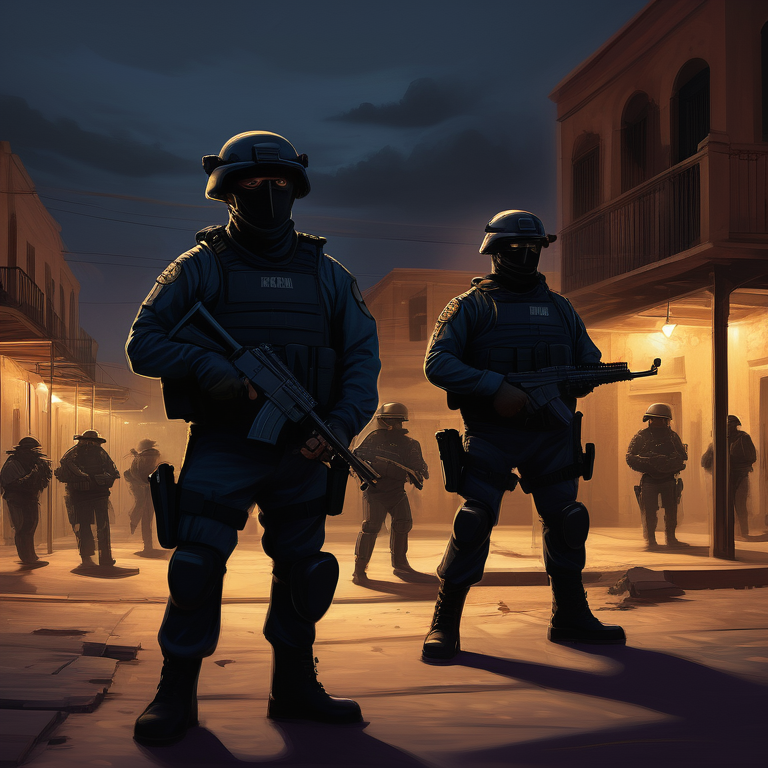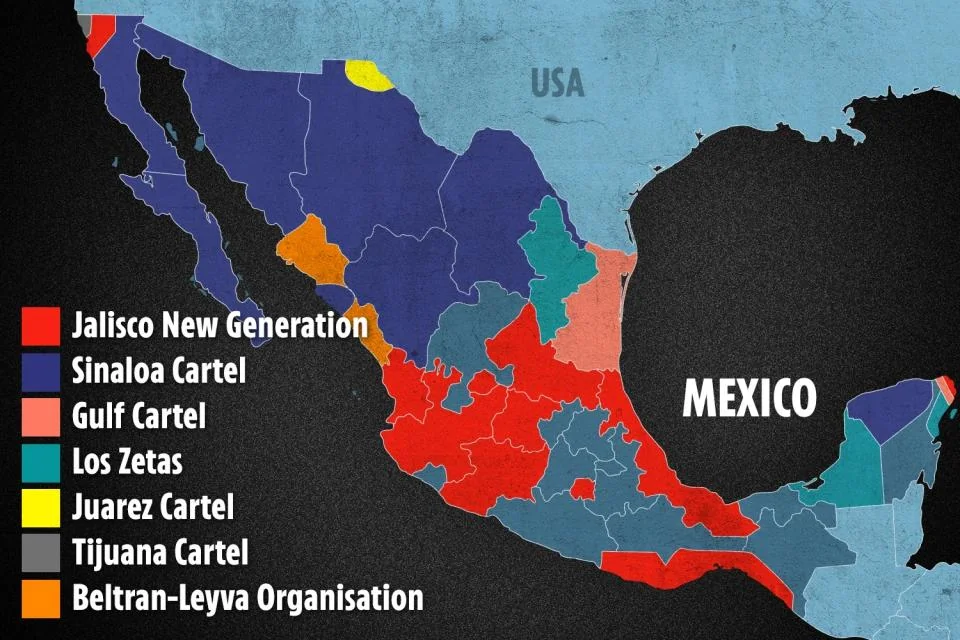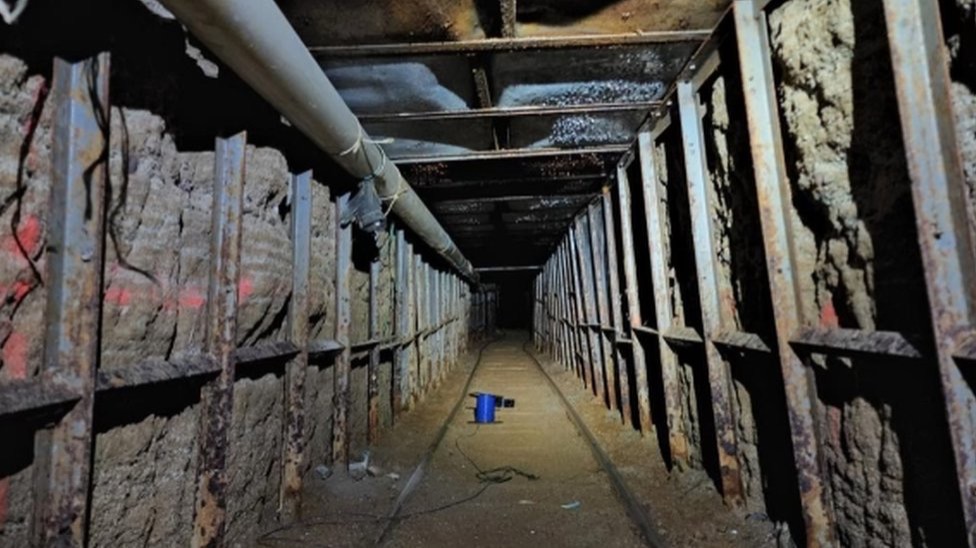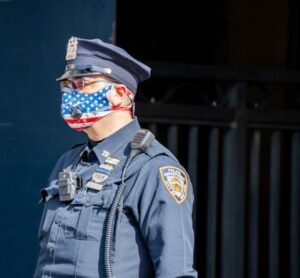Tackling the Growing Menace: Prominent Mexican Family Threat
Confronting the Prominent Mexican Family Threat

Key Highlights
- Mexican cartels pose a significant threat to law enforcement agencies in the United States, engaging in illegal activities such as drug trafficking, money laundering, and human.
- The Sinal Cartel and the Cártel Jalisco Nuevo Generación (CJNG) are the dominant cartels responsible for inundating American streets with drugs.
- Cartels often attempt to bribe officials and place their own members in positions of power to gain influence over law enforcement agencies.
- The influence of Mexican cartels is not confined to the southern border states, with even small towns in the least populated states being impacted.
- Cartel activities in the United States include drug trafficking, money laundering, and violence, which strain police resources and erode community trust.
- Combating cartel influence requires a multifaceted approach involving international cooperation, innovative surveillance, and community policing strategies.
Introduction

Mexican cartels have become a growing threat to law enforcement agencies in the United States. These organized crime groups, also known as drug cartels, operate globally and engage in a variety of illegal activities, including drug trafficking, money laundering, and human trafficking. Their influence extends beyond the borders of Mexico and poses significant challenges to law enforcement agencies in the United States, as seen in the recent April 2023 indictment of 12 Sinaloa Cartel members for drug trafficking and money laundering.
The Sinaloa Cartel and the Cártel Jalisco Nuevo Generación (CJNG) are two of the major cartels responsible for inundating American streets with drugs. The Sinaloa Cartel is widely recognized as the most extensive criminal organization in Mexico, with a network of smaller organizations under its umbrella. It retains its power through international dominance, infiltration of the Mexican government, and an adaptable networked alliance structure. The CJNG, on the other hand, emerged in 2011 and has since become known for its acts of violence and aggressive expansion of operations.
Mexican cartels employ various tactics to gain influence over law enforcement agencies. They often attempt to bribe officials and place their own members in positions of power, allowing them to establish long-term influence within these organizations. This infiltration makes it challenging for law enforcement to detect and combat cartel activities on American streets. With the upcoming June 2 vote in Mexico, the threat of cartels is becoming increasingly violent, with hundreds of local candidates dropping out of the race due to threats and at least 34 people running for office being killed. This highlights the urgency of addressing the growing power of cartels and their impact on Mexican society.
The Evolution of Mexican Cartels

Mexican cartels have a long history rooted in the drug trade in Latin America. Over time, these organized crime groups have evolved and expanded their operations, becoming powerful entities that pose a significant threat to law enforcement and security in the region. The origins of Mexican cartels can be traced back to the early 20th century, when drug trafficking became prevalent in the region. Since then, they have grown in sophistication and power, adapting to changing circumstances and expanding their influence both within Mexico and internationally. In fact, their influence has become so widespread that even the month of November is now associated with their violent actions, as seen in the targeted attacks that occurred on a November morning.
Origins and Expansion of Cartel Influence
The origins of Mexican cartels can be traced back to the early 20th century when drug trafficking became prevalent in Mexico. The country's geographic location, bordering the United States and serving as a transit point for drug smuggling, made it an attractive base for organized crime groups. The influence of cartels expanded as they formed alliances with ethnic groups involved in drug trafficking, such as the Guadalajara Cartel in the 1980s.
The expansion of cartel influence can also be attributed to the profitability of the drug trade. The demand for illegal drugs, particularly in the United States, created a lucrative market that cartels sought to control. As their power grew, cartels diversified their illegal activities, including extortion, kidnapping, and human trafficking, further expanding their influence and reach.
Major Cartels and Their Territories

Major Mexican cartels operate in different regions of the country, controlling specific territories. The Sinaloa Cartel, led by Ismael "El Mayo" Zambada and his sons, dominates the drug trade in northwestern Mexico. Its territories include the states of Sinaloa, Sonora, Chihuahua, Durango, and Baja California. The Sinaloa Cartel has also expanded its influence internationally, with a presence in more than 50 countries.
The Cártel Jalisco Nuevo Generación (CJNG), led by Nemesio "El Mencho" Oseguera Cervantes, is another major cartel operating in Mexico. It controls territories in states such as Jalisco, Michoacán, Colima, and Guanajuato. The CJNG has gained notoriety for its acts of violence and aggressive expansion of operations.
| Cartel | Territories |
| Sinaloa Cartel | Sinaloa, Sonora, Chihuahua, Durango, Baja California |
| CJNG | Jalisco, Michoacán, Colima, Guanajuato |
Cartel Operations and Law Enforcement Challenges
Cartel operations pose significant challenges to law enforcement agencies in the United States. The Drug Enforcement Administration (DEA) and other federal agencies work tirelessly to combat the influence and activities of Mexican cartels. However, the cartels employ various tactics to evade detection and prosecution.
One of the challenges law enforcement faces is the infiltration of cartels into government institutions and the judiciary. Cartels often attempt to bribe government officials and place their own members in positions of power, making it difficult for law enforcement to effectively investigate and prosecute criminal elements involved in cartel activities. The corruption of local authorities is also a major challenge, as it hampers efforts to gather intelligence and disrupt criminal elements involved in cartel operations.
Drug Trafficking and Distribution Networks

Drug trafficking is one of the primary activities of Mexican cartels, and the United States is a major destination for their illicit drugs. The southern border between the United States and Mexico serves as a primary transit point for drug smuggling operations.
Mexican cartels use a variety of methods to transport drugs across the border, including hidden compartments in vehicles, tunnels, and human couriers. They collaborate with local gangs in the United States to distribute substances such as methamphetamine, cocaine, heroin, and fentanyl products.
The Drug Enforcement Administration (DEA) has identified regions in the United States where Mexican cartels have established influence. These regions include areas in California, Arizona, New Mexico, and Texas, but cartel activities are not confined to these states. Even small towns in the least populated states can be impacted by the drug trade.
Money Laundering and Economic Impact

In addition to drug trafficking, Mexican cartels are involved in money laundering to hide the profits generated from their illegal activities. Money laundering enables cartels to integrate their illicit funds into the legitimate economy, making it difficult for law enforcement to trace and seize their assets.
The economic impact of Mexican cartels extends beyond the drug trade. The enormous profits generated from drug trafficking and other illegal activities, often just miles away from local businesses and government officials, have the potential to destabilize local economies and corrupt local governments. Cartels often use their financial resources to influence businesses, politicians, and law enforcement officials, further exacerbating the challenges faced by law enforcement agencies in their efforts to combat the growing threat of organized crime.
The exact amount of money laundered by Mexican cartels is difficult to determine, but estimates suggest that it could be billions of dollars annually. The vast sums of money involved enable cartels to maintain their operations, expand their influence, and perpetuate violence and corruption.
Violence and Corruption Tactics
Mexican cartels employ violence and corruption as tactics to protect their operations and maintain control over their territories. Violence is a hallmark of their activities, and they use it to intimidate rival cartels, control local populations, and exert influence over law enforcement agencies.
Cartels often engage in brutal acts of violence, including murders, kidnappings, and torture, to instill fear and maintain control. This violence extends beyond their territories in Mexico, with cartel-related violence also occurring in the United States.
Corruption is another tactic used by cartels to protect their interests and evade law enforcement. They bribe government officials, law enforcement officers, and even members of the judiciary to ensure that their activities go undetected and unpunished. The corruption of local authorities undermines law enforcement efforts and erodes public trust, making it even more challenging to combat cartel influence.
Impact on U.S. Law Enforcement and Border Security
The activities of Mexican cartels have a significant impact on U.S. law enforcement agencies and border security. The Drug Enforcement Administration (DEA) and other federal agencies dedicate substantial resources to combatting cartel influence and drug trafficking.
Law enforcement agencies face the daunting task of allocating time and resources to investigate and disrupt cartel activities. The resource-intensive nature of countering crimes resulting from cartel operations can strain police departments and hamper their ability to effectively address other criminal activities within their communities.
The southern border between the United States and Mexico is a critical area for border security. Cartels utilize the border to transport drugs and other contraband, posing a challenge to border security agencies. Securing the border and preventing the entry of illicit drugs, migrants, and individuals involved in cartel activities is a top priority for U.S. law enforcement. The number of migrants crossing the U.S.-Mexico border has tripled since 2019, with many citing violence and extortion as reasons for leaving their home country. This influx of migrants has added to the already complex and dangerous situation for law enforcement at the border.
Prominent Mexican Family Threat to U.S.
Mexican cartels engage in cross-border operations, smuggling drugs and other contraband into the United States. The Drug Enforcement Administration (DEA) and other federal agencies work in collaboration with Mexican law enforcement agencies to disrupt these operations and target high-level cartel members.
What are some of the threats faced by prominent Mexican families?
Prominent Mexican families face threats such as extortion, kidnapping, and violence from powerful cartels seeking control or retribution. Their wealth and influence make them targets for criminal organizations vying for power and resources in the region.
The United States has implemented various strategies to address the threat posed by Mexican cartels. These strategies include increased intelligence sharing, joint operations, and targeted enforcement actions. The DEA plays a crucial role in coordinating efforts between U.S. and Mexican law enforcement agencies to combat cartel influence and drug trafficking.
However, the influence and operations of Mexican cartels continue to pose significant challenges to U.S. law enforcement. The complex nature of the drug trade and the adaptability of cartels require ongoing collaboration and innovative approaches to disrupt their activities and dismantle their networks.
Case Studies of Cartel-Related Violence in the U.S.
Cartel-related violence has not been confined to Mexico, as incidents of violence linked to Mexican cartels have occurred in the United States as well. These cases highlight the far-reaching impact and influence of Mexican cartels.
One example is the case of the Sinaloa Cartel member, Joaquín "El Chapo" Guzmán, who was extradited to the United States and convicted on multiple charges, including drug trafficking and murder. Guzmán's trial shed light on the inner workings of the Sinaloa Cartel and its operations in the United States.
Another case involves the CJNG, which has been responsible for a wave of violence in Mexico and has expanded its operations into the United States. The CJNG has been linked to numerous incidents of violence, including high-profile assassinations and attacks on law enforcement officers.
These case studies serve as reminders of the ongoing threat posed by Mexican cartels and the need for continued efforts to combat their influence and activities.
Strategies for Combating Cartel Influence
Combating cartel influence requires a multifaceted approach that involves international cooperation, innovative surveillance techniques, and community policing strategies.
International cooperation is crucial in disrupting cartel operations and apprehending high-level cartel members. Law enforcement agencies in Mexico and the United States must work together to share intelligence, coordinate efforts, and target the financial networks that support cartel activities.
Innovative surveillance techniques, such as the use of advanced technology and data analysis, can help law enforcement agencies identify and disrupt cartel operations. This includes monitoring social media platforms used by cartels for recruitment and collaboration with American gangs.
Community policing strategies, which involve building trust and cooperation between law enforcement agencies and the communities they serve, are essential in combating cartel influence. By fostering relationships with community members, law enforcement can gather valuable intelligence, prevent cartel recruitment, and address the root causes of drug trafficking and violence.
International Cooperation and Intelligence Sharing
International cooperation and intelligence sharing are critical components in combating the influence and activities of Mexican cartels. Law enforcement agencies in Mexico and the United States must work together to share information, coordinate operations, and target the financial networks that fuel cartel activities.
Government officials from both countries play a crucial role in facilitating international cooperation. Bilateral agreements and joint task forces enable law enforcement agencies to collaborate effectively and exchange intelligence on cartel operations.
Intelligence sharing is essential in identifying and apprehending high-level cartel members, disrupting their operations, and dismantling their networks. The exchange of information on drug trafficking routes, money laundering schemes, and the movement of cartel members is vital for successful investigations and prosecutions.
International cooperation and intelligence sharing are ongoing efforts that require continued commitment from both countries to combat the evolving tactics and strategies employed by Mexican cartels.
Innovations in Surveillance and Drug Interdiction

Innovations in surveillance technology and drug interdiction play a key role in combating cartel influence and disrupting their operations. Law enforcement agencies are continually adopting new tools and techniques to stay ahead of cartels' evolving tactics.
Advanced surveillance technology, such as drones, high-resolution cameras, and data analytics, allows law enforcement to monitor cartel activities more effectively. These tools aid in detecting and tracking drug trafficking routes, identifying cartel members, and gathering evidence for successful prosecutions.
Drug interdiction efforts have also been enhanced with the development of new detection methods and equipment. K-9 units trained to identify narcotics, high-tech scanning devices, and improved border security measures contribute to the interception and seizure of illegal drugs.
By leveraging these innovations in surveillance and drug interdiction, law enforcement agencies can improve their effectiveness in combating cartel influence and disrupting their operations.
Community Policing and Rehabilitation Programs
Mexican cartels pose a significant threat to law enforcement agencies in the United States, with their involvement in drug trafficking, money laundering, and human trafficking. To combat this growing threat, it is crucial to implement effective strategies such as community policing and rehabilitation programs.
Community policing focuses on building strong relationships between law enforcement agencies and local communities. By establishing trust and cooperation, law enforcement can gain valuable information about cartel activities and disrupt their operations. This approach emphasizes proactive engagement with community members and addressing the root causes of crime to prevent cartel recruitment.
Rehabilitation programs play a crucial role in breaking the cycle of cartel involvement. By providing support and resources to individuals who have been involved in cartel activities, these programs aim to reintegrate them into society and reduce their chances of re-offending. This can include access to education, job training, mental health services, and substance abuse treatment.
Local communities play a vital role in the success of community policing and rehabilitation programs. By actively participating in crime prevention efforts and supporting individuals who are seeking to leave the grip of cartels, community members can contribute to creating safer neighborhoods and reducing the influence of cartels.
Legal and Policy Frameworks
The fight against Mexican cartels requires a strong legal and policy framework to effectively address their illicit activities. Legal frameworks and drug policies play a crucial role in guiding law enforcement efforts and providing a basis for prosecution.
Legal frameworks establish the laws and regulations that govern drug trafficking and other criminal activities. They define the penalties for these offenses and outline the procedures for investigation, prosecution, and sentencing. Strong legal frameworks empower law enforcement agencies to take action against cartels and hold them accountable for their crimes.
Policy frameworks, on the other hand, guide the overall approach to drug policy and law enforcement strategies. They inform the allocation of resources, prioritize certain areas of enforcement, and promote collaboration between different agencies and jurisdictions. Effective policy frameworks ensure a coordinated and comprehensive response to the threat posed by Mexican cartels.
The development and implementation of these frameworks require collaboration between federal, state, and local authorities. It is vital to ensure that laws and policies are regularly reviewed and updated to address the evolving tactics of cartels and stay ahead of their operations.
U.S. Drug Policy and Its Effectiveness
The United States drug policy plays a crucial role in addressing the threat posed by Mexican cartels. The effectiveness of this policy, however, has been a subject of debate.
The U.S. drug policy focuses on a combination of law enforcement efforts, prevention and education programs, and treatment and rehabilitation services. The goal is to reduce drug use, disrupt the supply chain, and dismantle drug trafficking organizations. However, critics argue that the emphasis on law enforcement and prosecution has not been successful in reducing drug availability or addressing the root causes of drug addiction.
Law enforcement efforts have led to the arrest and prosecution of cartel members and the seizure of drugs and assets. However, cartels have shown resilience and adaptability, finding new ways to evade law enforcement and continue their operations. This highlights the need for a comprehensive approach that also includes prevention and treatment strategies.
Prevention and education programs aim to raise awareness about the dangers of drug use and provide support to individuals at risk. These programs focus on young adults, as they are particularly vulnerable to cartel recruitment and drug addiction. By equipping them with knowledge and skills to make informed decisions, these programs can help prevent involvement with cartels.
Treatment and rehabilitation services are essential for individuals struggling with drug addiction and those seeking to leave the grip of cartels. Access to quality treatment programs, including mental health services and support groups, is crucial for successful recovery and reintegration into society.
Overall, the effectiveness of U.S. drug policy in addressing the threat posed by Mexican cartels requires a balanced approach that combines law enforcement efforts, prevention and education programs, and treatment and rehabilitation services.
Mexican Government Initiatives and Challenges
The Mexican government has taken various initiatives to address the threat posed by Mexican cartels. These initiatives aim to disrupt cartel operations, strengthen law enforcement agencies, and promote community safety. However, they also face significant challenges in their implementation.
One of the key initiatives is the deployment of federal forces to regions heavily impacted by cartel activities. These forces work in collaboration with local authorities to combat drug trafficking, dismantle cartel networks, and restore law and order. The Mexican government has also established specialized units within law enforcement agencies to focus on combating cartels and organized crime, including deportation efforts of illegal immigrants involved in cartel activities. This includes working with the INS to identify and remove individuals involved in cartel activities through deportation.
Another initiative is the promotion of international cooperation in tackling transnational criminal organizations. The Mexican government works closely with international partners, particularly the United States, to share intelligence, coordinate operations, and extradite cartel members for prosecution.
Despite these initiatives, the Mexican government faces challenges in effectively combating Mexican cartels. Corruption within law enforcement agencies and the judicial system remains a significant obstacle. Cartels often attempt to bribe officials and infiltrate these institutions, compromising their effectiveness and hindering law enforcement efforts.
Another challenge is the high level of violence associated with cartel activities. Cartels employ brutal tactics to intimidate and maintain control, leading to a culture of fear and mistrust. This poses challenges for law enforcement agencies in gaining the cooperation and support of local communities.
Addressing these challenges requires a multi-faceted approach, including strengthening anti-corruption measures, investing in law enforcement training and resources, and fostering community engagement and trust-building efforts.
The Role of the Public and Civil Society
In the fight against Mexican cartels, the role of the public and civil society is crucial. Their awareness efforts and support play a significant role in combating cartel influence and promoting community safety.
The public has a responsibility to be vigilant and report any suspicious activities to law enforcement. By being aware of the signs of cartel presence and involvement, community members can contribute to the detection and prevention of cartel activities. This can include reporting drug trafficking, money laundering, or other illicit activities to the appropriate authorities.
Civil society organizations also play a vital role in raising awareness about the dangers of cartel involvement and advocating for effective policies and programs. These organizations work to educate the public, particularly young adults, about the risks and consequences of cartel activities. They also provide support and resources to individuals affected by cartels, including victims of violence and their families.
Awareness and Education Efforts
Awareness and education efforts are key in combating the influence of Mexican cartels. By raising awareness about the dangers of cartel involvement, these initiatives aim to prevent recruitment and reduce demand for illicit substances.
One focus of awareness and education efforts is young adults, as they are particularly vulnerable to cartel recruitment and drug addiction. Programs target schools and colleges, providing information about the risks and consequences of cartel involvement. They also equip young adults with the necessary skills to resist peer pressure and make informed decisions.
Campaigns and public service announcements aim to reach a broader audience, raising awareness about the impact of cartels on communities and the importance of reporting suspicious activities. These initiatives emphasize the role of the public in helping law enforcement agencies combat cartels and promote community safety.
Civil Society Movements and Victim Support Groups
Civil society movements and victim support groups play a crucial role in supporting individuals affected by cartel activities and advocating for their rights. They provide support services, raise awareness, and promote community support.
Victim support groups offer assistance to individuals who have experienced violence or other forms of harm as a result of cartel activities. They provide counseling, legal support, and resources to help victims navigate the challenges they face. These groups also advocate for policies and programs that prioritize victim support and access to justice.
Civil society movements work to raise awareness about the impact of cartels on communities and mobilize public support for action. They organize protests, campaigns, and community events to bring attention to the issue and push for policy changes. These movements also work to create networks of support within communities, fostering resilience and solidarity.
Together, civil society movements and victim support groups contribute to building a united front against Mexican cartels, promoting community support and advocating for the rights and well-being of those affected by their activities.
Conclusion
In the midst of escalating violence and corruption, combating Mexican cartels requires a multi-faceted approach. International cooperation, advanced surveillance techniques, and community engagement are crucial in addressing the growing threat they pose. By sharing intelligence, enhancing drug interdiction initiatives, and implementing rehabilitation programs, law enforcement agencies can work towards dismantling cartel operations. Additionally, public awareness and education efforts play a pivotal role in safeguarding communities from cartel violence. Together, through collaborative strategies and active participation, we can strive to mitigate the influence of Mexican cartels on both sides of the border.
Frequently Asked Questions
What are the most powerful cartels in Mexico today?
The Sinaloa Cartel and the Cártel Jalisco Nuevo Generación (CJNG) are currently the most powerful cartels in Mexico. The Sinaloa Cartel is widely recognized as the most extensive criminal organization in Mexico, with an adaptable networked alliance structure that extends to multiple countries. The CJNG, on the other hand, has aggressively expanded its operations, particularly in the distribution of Mexican methamphetamine, heroin, and fentanyl in the United States.
How can communities protect themselves from cartel violence?
Communities can protect themselves from cartel violence by actively participating in crime prevention efforts and working closely with local governments and law enforcement agencies. It is crucial for community members to report any suspicious activities to the appropriate authorities and provide information that can help law enforcement disrupt cartel operations. Building strong relationships between law enforcement and the community through initiatives like community policing can also contribute to community safety.
https://freedomhouse.org/country/mexico
hhttps://www.nytimes.com/2000/08/16/world/suit-filed-over-leak-of-report-on-mexican.html
https://www.unicef.org/reports/country-regional-divisional-annual-reports-2021/Mexico
https://2009-2017.state.gov/r/pa/prs/dpb/2009/dec/133808.htm
https://ktla.com/news/mexican-drug-cartels-operating-on-a-very-large-scale-in-big-sky-country
https://link.springer.com/article/10.1007/s10826-017-0755-z
https://minorityhealth.hhs.gov/omh/browse.aspx
https://optn.transplant.hrsa.gov/data/view-data-reports/national-data

